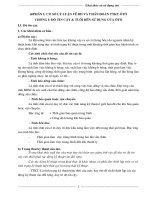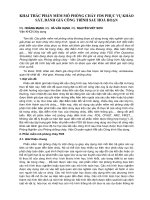GIÁO TRÌNH KHAI THÁC PHẦN mềm TRONG GIA CÔNG KHUÔN mẫu chapter IX bulk forming processes
Bạn đang xem bản rút gọn của tài liệu. Xem và tải ngay bản đầy đủ của tài liệu tại đây (9.32 MB, 20 trang )
1
Chapter IX: Bulk Forming (Forging)
1
Content:
Forging
• Introduction
• Examples of Application
• Overview to Basic Forging
Processes
• Open-Die Forging
• Forging Machine Tools
• Closed-Die Forging
• Forging Temperature
• Forging Defects
• Forging Dies
• Current Trends
Chapter IX: Bulk Forming (Forging)
2
Description of Forging
Advantages of Forging Process:
• High material utilization
• High production rates
• High process stability
• High recyclability of products
Forging consists of a group of manufacturing processes which are
mainly deformation processes. The two other types of processes are
separating (parting) and joining processes.
In order to reduce stresses and forces and to increase formability,
forging is usually carried out after heating to a temperature range at
which recovery and recrystallization occurs. Hence the workpieces after
forging do not show a permanent work hardening.
Advantages of Forged Products:
• Improved grain structure
• Higher fatigue strength & ductility
• Better surface quality than in casting
• Beneficial grain flow (fibers)
2
Chapter IX: Bulk Forming (Forging)
3
Material Fibers (Grain Flow)
Casting ForgingMachining
Forging Industry Association
The beneficial grain flow in forged parts leads to a longer
fatigue life & higher ductility than machined or casted parts.
ASM Handbook
Chapter IX: Bulk Forming (Forging)
4
Forging Production
2.368.000
35.000
1.360.000
9.600.000
0
3.000.000
6.000.000
9.000.000
12.000.000
Turkey
(1989)
Germany
(1999)
Europe
(1998)
World
(1998)
Closed Die Forged Parts in t
Tekkaya/Hirschvogel
3
Chapter IX: Bulk Forming (Forging)
5
Examples of
Application:
Various
Parts
IDS
Chapter IX: Bulk Forming (Forging)
6
Examples of Application:
Front Axle of a Truck
Daimler Benz AG
4
Chapter IX: Bulk Forming (Forging)
7
Examples of
Application:
Automobile Front
Wheel
Suspension
BMW AG
Chapter IX: Bulk Forming (Forging)
8
Examples of Application: Truck Gear Box
Daimler Benz AG
5
Chapter IX: Bulk Forming (Forging)
9
Examples of Application: Vehicle Power Shaft
Gelenkwellenbau Gmbh
Chapter IX: Bulk Forming (Forging)
10
Examples of
Application:
Aircraft Landing
Gear Structure
Airbus Industrie
6
Chapter IX: Bulk Forming (Forging)
11
Basic Forging Processes
Open-Die Forging
Closed-Die Forging
Hot Forging
Warm Forging
Cold Forging
Precision Forging
Near-Net-Shape-Forging
Net-Shape Forging
Isothermal Forging
Chapter IX: Bulk Forming (Forging)
12
Hot versus Cold Forging
Hot Forging
• Production of discrete parts
• Greater technical and
economical importance
• Low stresses, no/low work-
hardening, homogenized
grain structure
• High formability
• Medium to low accuracy
• Scale formation
• Forging temperatures:
– Steel: > 1000
o
C (up to 1150
o
C)
– Al-Alloys: 360
o
C-520
o
C
– Cu-Alloys: 700
o
C-800
o
C
Cold Forging
• Production of discrete parts
• Processes covered: extrusion
forging, upsetting, coining
• High stresses, strain
hardening, high die loads
• Limited formability
• Near-net shape or net shape
• High surface quality
7
Chapter IX: Bulk Forming (Forging)
13
Open-Die versus Closed-Die Forging
Open-Die Forging
• Aim: To achieve a convenient
mass distribution or shape for the
successive operations
(machining or closed-die forging)
• Simple tools, whose geometry do
not depend on the product
geometry
Closed-Die Forging
• Aim: Achieve best possible
dimensional and shape accuracy
of the product.
• Tools whose geometry is product
dependent
Chapter IX: Bulk Forming (Forging)
14
Open Die Forging
Cogging
Video
Upsetting
Heading (with no given form)
Spreading
Radial Forging (with no given form)
Kalpakjian
Geiger
Lange
8
Chapter IX: Bulk Forming (Forging)
15
Basic Processes of Open-Die Forging and
Achievable Cross-Section Changes
Open-Die Forging Processes Cross-Section Change
Cogging, spreading A
0
/A
1
4-5
Upsetting, heading A
1
/A
0
< 4-5
• Cogging (material displacement)
• Spreading (material displacement)
• Upsetting, heading (material concentration)
Chapter IX: Bulk Forming (Forging)
16
Complete
Plastification
During
Cogging
Lange
9
Chapter IX: Bulk Forming (Forging)
17
Closed Die Forging (1)
Impression Die Forging
Video
Closed Die Forging (no flash)
Coining
Heading
Video
Kalpakjian
Chapter IX: Bulk Forming (Forging)
18
Closed Die Forging (2)
Roll-Forging
Skew-Roll-Forging
Upsetting in a Die
Kalpakjian
10
Chapter IX: Bulk Forming (Forging)
19
Closed
Die
Forging
(3)
Radial Forging
(Swaging)
Kalpakjian
Chapter IX: Bulk Forming (Forging)
20
Terminology for Impression Die
Forging
Kalpakjian
11
Chapter IX: Bulk Forming (Forging)
21
Material Flow in Closed-Die Forging
Upsetting Spreading Rising
Geiger/Lange
Chapter IX: Bulk Forming (Forging)
22
Lange
Work W
Stroke
Force F
s
b
1
b
2
plasticregion
rigidregion
lowerdie
workpiece
upperdie
A
F1
A
F2
A
dc
r
z
stresses
s
r
s
r
s
z
s
z
r
s
f
s
f
s
z,flash,max,2
s
z,flash,max,1
b
1
<
b
2
Mechanics of
Closed-Die Forging
12
Chapter IX: Bulk Forming (Forging)
23
Effect of Flash Dimesions
0 2 4 6 8 10
Die Land- Ratiob/s
1200
1000
800
600
400
200
0
AxialStressinFlash inMPas
zmax
30
25
20
15
10
5
0
ExcessMaterial Dm in%
5500
5000
4500
4000
3500
3000
2500
ForgingForce inkNF
55
50
45
40
35
30
25
ForgingWork kNminW
s
zmax
Dm
W
F
80mm
Vieregge
Chapter IX: Bulk Forming (Forging)
24
Stress and Force Computation in
Impression Die Forging: Slab Method
In the flash land the axial stress is given according to the slab
method by Siebel as:
max
1 2
z f
b
s
σ σ µ
= − ⋅ + ⋅ ⋅
Simple method to estimate the forging load:
max max
P z
F A
σ
= ⋅
where, the total projection area A
p
is given by:
P dc F
A A A
= +
A
dc
: Projection area of die cavity, A
F
: Projection area of flash
13
Chapter IX: Bulk Forming (Forging)
25
s
plasticregion
rigidregion
rigidregion
d
D
Stress and Force Computation in Impression
Die Forging: Upper Bound Method
• The material within the die cavity does not
plastify anymore as the maximum force is
recorded, since all free places are filled already.
• The material flow happens only in the material
slab of thickness s, i.e. the flash thickness. The
shape of the die cavity is therefore immaterial.
Assumptions for die with steep and deep cavities:
2 3 3 3
max
2
4 3 8
12 3
f
D d D d
F
s
s
σ π µ
−
= ⋅ ⋅ + + ⋅ ⋅
⋅
⋅
2 3 3 3
max
4 24 12
f
D d D d
F
s s
σ π µ
−
= ⋅ ⋅ + + ⋅
⋅ ⋅
(v. Mises)
(Tresca)
0.3 0.5 (0.577)
µ
< <
Lange
Chapter IX: Bulk Forming (Forging)
26
Typical Hot Flow Curves for Ck45
0
100
200
300
400
0 0.2 0.4 0.6 0.8 1 1.2
Equivalent plastic strain
Flow stress in MPa
T = 800
o
C
1
40
s
ε
−
=
&
1
8
s
−
1
1.6
s
−
1
40
s
−
1
8
s
−
1
1.6
s
−
T = 1000
o
C
T = 1200
o
C
1
40
s
−
1
8
s
−
1
1.6
s
−
MSC/AutoForge
14
Chapter IX: Bulk Forming (Forging)
27
Forging Press Characteristics
Forging Press
Impact Speed of
Tool
Pressure Time
High-Speed Hammers
16 m/s 0.5 – 5 ms
Drop-Forging Hammer
6 m/s 1 – 10 ms
Crank Press (
1 m/s) 20 – 100 ms
Friction Screw Press
0.5 m/s 50 – 150 ms
Hydraulic Press
0.1 m/s 250 – 500 ms
Lange
Chapter IX: Bulk Forming (Forging)
28
Forging Presses (1)
Hydraulic Press Eccentric Press
Kalpakjian
15
Chapter IX: Bulk Forming (Forging)
29
Forging Presses (2)
Knuckle Joint
Press
Friction Screw
Press
Gravity Drop Hammer
Kalpakjian
Chapter IX: Bulk Forming (Forging)
30
Kalpakjian
Example for Forging Sequences
16
Chapter IX: Bulk Forming (Forging)
31
Examples of Forged Parts
Courtesy Kanca
Chapter IX: Bulk Forming (Forging)
32
Closed-Die
Forging
without
Flash:
Example
17
Chapter IX: Bulk Forming (Forging)
33
Closed-Die Forging without Flash: Force-
Displacement Diagram
Forging Force in tons
Punch Stroke in mm
Upsetting
Corner Filling
Johne
Chapter IX: Bulk Forming (Forging)
34
Closed-Die Forging without Flash:
Material Flow
Punch
Die
unfilledcorner
plasticzone
sticking
zone
Workpiece
Lange
18
Chapter IX: Bulk Forming (Forging)
35
Forging Temperature
• Lower Temperature: Significantly larger than the
recyrstallization temperature
• Upper Temperature: As large as possible, but if too
large:
– Oxidation or melting of impurities at the grain boundaries
– Excessive grain grow (overheating)
– Increased scale formation and decarburization
– Tendency of fracture on the blank surface
• Workpiece temperature is neither in time nor in space constant:
– Heat losses due to radiation and conduction
– Heat gain by friction and forming work
Chapter IX: Bulk Forming (Forging)
36
Forging Defects
Kalpakjian
19
Chapter IX: Bulk Forming (Forging)
37
Forging Dies: Failure
Kannappan
Wear (abrasion)
Thermal fatigue
Mechanical fatigue
Plastic deformation
Chapter IX: Bulk Forming (Forging)
38
Forging Dies: Design
• Positioning the forging stages
• Design of die land and flash gutter
• Design of the die cavity
– Design for material flow and die layout
– Design for dimensional accuracy
– Design for ease of machining
20
Chapter IX: Bulk Forming (Forging)
39
Current Trends
• Thixo-Forging:
– Combination of casting and forming
– Thixotropic state: both liquid and solid
states co-exist
– Materials: basically aluminum and
magnesium alloys
– Advantages:
• Low forging loads
• Complicated shapes can be forged in
one stage
• Near-net forming (as compared to
casting)
• Large wall thickness differences
possible
– Disadvantages:
• Very tight temperature window
• Advance tool technology necessary
• Not all materials can be thixoforged
• Precision Forging of
Gears
– Precision forging: Forging
with higher precision than
described in the standards
– Higher tool costs are
compensated by saving
post-machining costs
Chapter IX: Bulk Forming (Forging)
40
Computer Aided Forging
unkown owner









